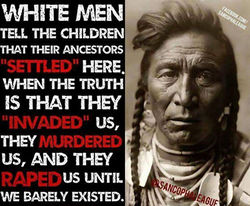Template:The Nativity of Oppression
The Nativity of Oppression

The desire to divide people by race, describe the character or morality of people by race, or organize people in some form of intersectionality by race is racist. We can and should only measure and judge individual people according to their present character and personal deeds and past actions if we truly desire equality.
The historical fact is some European whites protected, defended, and befriended native people and some also abused them. But it is also a fact that some native tribal people were killing, invading, enslaving, raping each other from one end of the Americas to the other while there were also good moral native Americans who were more than worthy of our praise and gratitude. Some of the white settlers and native Americans, African people were both good and band or righteous and wicked or moral and evil within the same lifetime.
Dividing good and evil by race is the definition of what a racist does and that is both unproductive and a snare of the heart.
The Aztecs as a nation were killing and enslaving people by the tens of thousands[1] because they had the power to do so until the Spanish came with more power and aided some freedom fighting Aztecs and their neighbors in overthrowing that brutal regime. This as all possible because of Columbus, who may have been an answer to those brutalized victims' prayers.
Each generation, each man and each woman must guard themselves against the spirit of lies and prejudice which leads to tyranny. Even a modern voter in a democracy may have the seed of tyranny growing in their heart when they wield the power to oppress their neighbor and force him to pay for the benefits they want.
Columbus is dead. He has crossed the great divide that we all encounter sooner or later. Was he Saint or sinner? Probably a little of both from time to time.
- ↑ Jump up to: 1.0 1.1 "Some post-conquest sources report that at the re-consecration of Great Pyramid of Tenochtitlan in 1487, the Aztecs sacrificed about 80,400 prisoners over the course of four days. This number is considered by Ross Hassig, author of Aztec Warfare, to be an exaggeration. Hassig states "between 10,000 and 80,400 persons" were sacrificed in the ceremony." Wikipedia